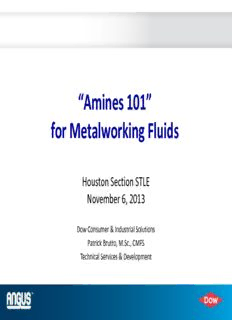
“Amines 101” for Metalworking Fluids PDF
Preview “Amines 101” for Metalworking Fluids
“Amines 101” for Metalworking Fluids Houston Section STLE November 6, 2013 Dow Consumer & Industrial Solutions Patrick Brutto, M.Sc., CMFS Technical Services & Development Overview • Application areas • Neutralizers vs. pH adjusters vs. pH buffers • Typical acids (good & bad) • Neutralizer characteristics & choices • pH adjuster characteristics & choices • pH buffer characteristics & choices • Secondary benefits • Health, safety & regulatory factors Primary Application Areas • Water-dilutable metalworking fluids – Metal removal (drilling, tapping, grinding, etc.) – Metal forming (drawing, rolling, stamping, etc.) Overview • Application areas • Neutralizers vs. pH adjusters vs. pH buffers • Typical acids (good & bad) • Neutralizer characteristics & choices • pH adjuster characteristics & choices • pH buffer characteristics & choices • Secondary benefits • Health, safety & regulatory factors Neutralizers vs. pH Adjusters vs. pH Buffers • Neutralizers – Typically used in initial formulation (concentrate) to form salts of acid-functional components (organic & inorganic acids) • pH Adjusters – Commonly added to virgin fluids to form stable concentrate/dilution & adjust alkaline pH – Sometimes added “tank-side” in MWF systems to restore starting pH of fluid Neutralizers vs. pH Adjusters vs. pH Buffers • pH Buffers – Added to concentrates to neutralize “bad acids” formed during use of fluid and to prevent pH drop (i.e. provide reserve alkalinity) – Sometimes added tank-side to renew buffering capacity of fluid Overview • Application areas • Neutralizers vs. pH adjusters vs. pH buffers • Typical acids (good & bad) • Neutralizer characteristics & choices • pH adjuster characteristics & choices • pH buffer characteristics & choices • Secondary benefits • Health, safety & regulatory factors Typical Acids • Functional acids (good) – Organic acids such as oleic, tall oil, nonanoic, decanedioic and many others provide: corrosion control, emulsification, lubrication – Inorganics such as boric acid & phosphate esters impart: corrosion control, biostatic effects, lubrication • Acid contaminants (bad) – By-products of microbial growth (short-chain organic acids) – Carbonic acid from dissolved carbon dioxide – Oxidative degradation products (mostly organic acids) – External contaminants (acid-based cleaners, etc.) Overview • Application areas • Neutralizers vs. pH adjusters vs. pH buffers • Typical acids (good & bad) • Neutralizer characteristics & choices • pH adjuster characteristics & choices • pH buffer characteristics & choices • Secondary benefits • Health, safety & regulatory factors The Ideal Neutralizer • Low Molecular Wt. – Less is needed to neutralize a given amount of acid • High Base Strength (pKa) – pKa is the pH where ½ the base is neutralized • At higher pHs less is neutralized, at lower pHs more is – Reaction of highest pKa neutralizer dominates • Favorable Salt Characteristics – A “salt” is the neutralization product of an acid & base (ionic bond) – Neutralizers can influence the performance of the corresponding salts • Corrosion control • Emulsification • Solubility • Microbial resistance • Lubrication
Description: